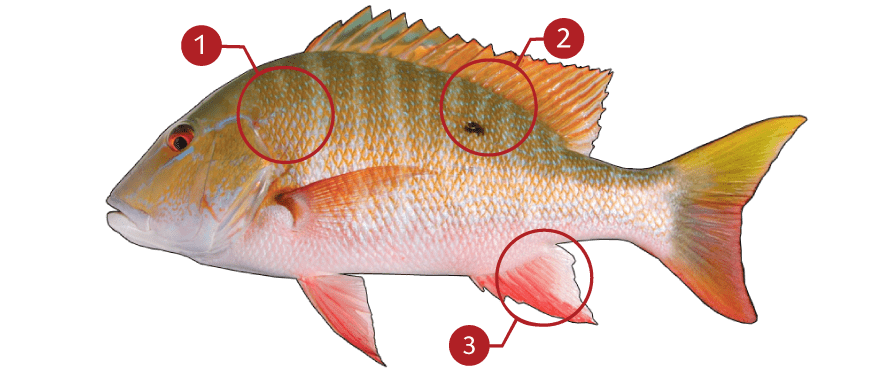MUTTON SNAPPER
How to identify a Mutton Snapper
It varies from orange to reddish-yellow with small blue streaks on the head, back, and flanks, with orange tinted fins. The colors may vary, as with most species of fish. A combination of factors distinguishes it from other snappers. There is a black, oval shaped spot on the upper flank on each side, the anal fin and rear edge of the dorsal fin is angulate (pointed rather than rounded), the tail is lunate, and the dorsal fin has ten spines and fourteen rays.Although at first glance the mutton snapper and the lane snapper may look exactly alike, both having similar colorations, a lunate tail and even the same oval spot on the upper flanks, a closer look will reveal that the lane snapper has yellow streaks or horizontal stripes on the body, whereas the mutton snapper has small, oblique, blue streaks on a yellowish background, though these tend to disappear with age. Also, the anal fin and rear edge of the dorsal fin of the lane snapper are not sharply pointed but appear to be squarish or even rounded. Of all the species of Lutjanidae having a dark spot on the flanks below the dorsal fin, the mutton snapper is the only one in which the tooth patch in the roof of the mouth has no median extension and resembles a crescent rather than an anchor shape. Large mutton snappers take on a reddish coloration and are often mistaken for red snappers.
Where to catch Mutton Snapper
The mutton snapper is a very common snapper species from Florida to South America. Occasionally, it reaches as far north as Massachusetts and as far south as southeastern Brazil but these are rare occurrences.
IDENTIFICATION

| |
Orange to reddish-yellow with small blue streaks on the head, back, and flanks, with orange tinted fins |
| |
A black, oval shaped spot on the upper flank on each side |
| |
The anal fin and rear edge of the dorsal fin is angulate (pointed rather than rounded) |
TARGET AREAS
|
|
Acknowledgements: We thank TAKEMEFISHING.org (www.takemefishing.org), Wisconsin Department of Natural Resources, Indiana Department of Natural Resources for their contributions to these FISH FACTS.

